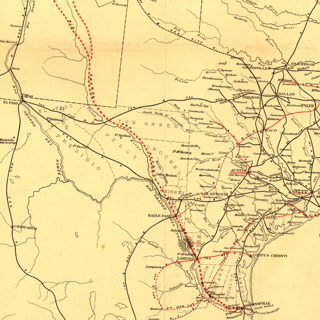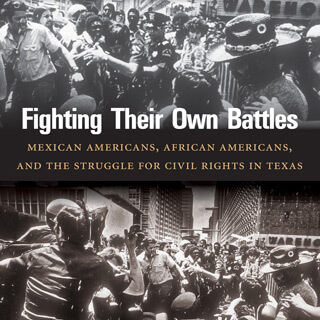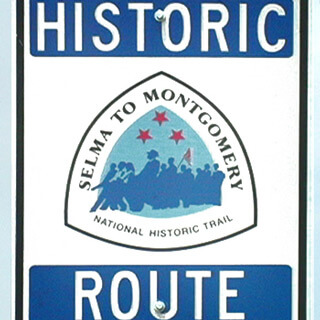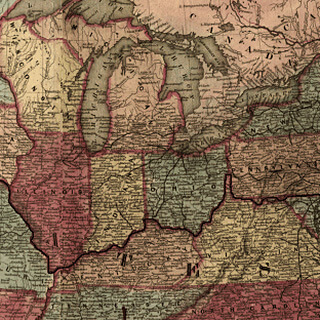Overview
Brent M.S. Campney reviews Will Guzmán's Civil Rights in the Texas Borderlands: Dr. Lawrence A. Nixon and Black Activism (Urbana: University of Illinois Press, 2015).
Review

Lawrence Aaron Nixon, born in Marshall, Texas, in 1883—as Will Guzmán chronicles in Civil Rights in the Texas Borderlands—grew to manhood at a time when whites in the Lone Star State, across the South, and indeed, across the entire United States, were vigorously undoing the gains achieved by blacks during the Civil War and Reconstruction, all the while imposing Jim Crow laws and practices. Despite these obstacles, Nixon graduated from Wiley College in Texas in 1902 and from Meharry Medical College in Tennessee in 1906.
Shortly after establishing his practice in Cameron, Texas, in 1907, Nixon witnessed an act of racist vengeance when a mob executed a black prisoner: "Nixon was at his medical office at the time and remembers 'that chairs were placed on the balcony of the two-story building to accommodate the crowds gathered to witness the lynching,' while he stayed behind locked doors in his office, 'listening to the cries of the dying man'" (27). Anxious to leave Cameron, but reluctant to return to Marshall where lynchers had recently killed four blacks, Nixon went west and settled in the rapidly growing city of El Paso in 1909.

Over the ensuing decades, Nixon played an important role in his adopted city as a physician and civil rights activist. Despite El Paso's relatively liberal reputation, blacks lived under stifling restrictions. Whites in El Paso limited Blacks to certain areas, such as the second ward neighborhood near downtown.
This could be done in subtle ways, but it was also often accomplished through overt tactics such as racially restrictive covenants that simply stated 'said property shall not be sold to nor occupied by Negroes, nor for any immoral use.' By forcing Blacks to live in overcrowded areas, racially restrictive covenants 'imposed social disintegration, social pathology, and personal ill health on them' (47).
As head of the El Paso Negro Ministerial Alliance, Nixon unsuccessfully petitioned the city in 1924 to honor its commitment to build a swimming pool for blacks in the city's principal park. He also became a founding member of the El Paso branch of the National Association for the Advancement of Colored People (NAACP). Even as the Ku Klux Klan assumed a major presence in El Paso, he "helped lay the foundation for Black voting rights in the South as the central plaintiff in two landmark US Supreme Court cases: Nixon v. Herndon (1927) and Nixon v. Condon (1932), and the little-discussed case of Nixon v. McCann (1934), Nixon's third attempt to dismantle the all-white Democratic primary." In so doing, he, "along with the NAACP, helped set legal precedent that ultimately led, in Smith v. Allwright (1944), to the dismantling of all-white primaries throughout the entire South" (67). Nixon was a strong candidate for plaintiff because he did not derive his income from whites, because he regularly paid his poll tax, and because—unlike most blacks—he was a registered Democrat who could plausibly claim the right to participate in the selection of the party candidate. Although Nixon and the NAACP prevailed in the first two cases, segregationists ultimately found loopholes that enabled them to maintain their exclusionary practices. Finally, between 1926 and 1934, Nixon invested his time and energy into establishing a hospital in El Paso for blacks suffering from tuberculosis, a dream that he pursued with his characteristic vigor but could not realize due to a lack of institutional support and funds.

An ambitious and courageous professional and activist, Nixon's life and works rightfully deserve scholarly attention. With his exploration of archival and oral history sources, Will Guzmán has undertaken an important subject. Nevertheless, Civil Rights in the Texas Borderlands does not reconcile the theory presented in its introduction with the aims and the substance of the book. For instance, Guzmán clearly assumes that the civil rights movement occurred after World War II, an assumption at odds with his effort to write a history of one civil rights activist in the pre- and post-World War I periods. Nixon's life reveals much about the engagement of black professionals "in so-called racial uplift during the pre-civil rights movement" (1), he writes in one place; in another, he declares that "the pre-civil rights movement paved the way for all future actions" (7). Guzmán frames his subject as important only as precursor to the real movement decades later rather than as part of a deeper social justice struggle. He also misses an opportunity to engage the vibrant debate over the long civil rights movement.
Although the book's title promises to situate Nixon in the borderlands, Guzmán doesn't follow through. He discusses the borderlands as concept and geographical space only in his introduction. Civil Rights in the Texas Borderlands makes surprisingly little effort to locate El Paso within this context and rarely invokes the larger social and racial milieu. The Mexican Revolution, an event of major importance, is barely mentioned. Nor did Nixon's activism reach across the "borderlands." The closest that Guzmán comes is in a reference to poet Langston Hughes's observation, after visiting El Paso, that "'it was strange to find that just by stepping across an invisible line into Mexico . . . so suddenly did Jim Crow disappear'" (46).

Cover page El Paso Morning Times, El Paso, Texas, January 30, 1917. Courtesy of University of North Texas Libraries Portal to Texas History, texashistory.unt.edu/ark%3A/67531/metapth198631/m1/1/sizes.
While Guzmán references Mexicans and Mexican Americans throughout the book, they play a peripheral role, irrelevant background characters in a story revolving around black-white relations (despite the fact that "Mexican and Mexican Americans were in the majority" (4) in El Paso). The author does not mention the Santa Ysabel massacre of 1915, the El Paso race riot of 1916, or the El Paso bath riots of 1917. These ugly conflicts involved white and ethnic Mexican combatants, profoundly shaped local and regional race relations, and must surely have influenced Nixon. Given these absences, Guzmán is unconvincing when he asserts that the "particular, if not unique, racial climate in El Paso, and by extension the borderlands, permitted Nixon to take a proactive stance and engage in a heightened level of activism" (112).
Guzmán situates his story "in the US West" (4), but this positioning also shifts in telling ways. He rightly challenges assumptions that the West was a racial utopia that differed markedly from the racist reality to the East, as "the western frontier did not turn out to offer the future southern Blacks had hoped for" (5). He never backtracks on that assertion, but he does make El Paso and its white citizens "southern" for the purposes of discussing a Jim Crow system that he views as inherently of the South. "Change was brewing for the South, and though for many the change brought hope, there were others who saw this change as a threat," he writes in his discussion of Nixon and the white primary. The rise of the Ku Klux Klan in El Paso and elsewhere proved that the Civil War "still burned in many southern communities" (68). He notes that the mayor was "a child of the segregated South who was born and raised during the Civil War and Reconstruction era," a man who "was not about to challenge the racial norms that [white] El Paso wanted to preserve" (63). Guzmán does not address the fact that, if whites in El Paso "wanted to preserve" segregation, they must have shared the mayor's "southern" views—irrespective of their sectional origins. (When another mayor—this one "from Iowa" (106)—vetoed an antidiscrimination measure in 1962, his racist attitudes aren't ascribed to Midwestern origins.) Wedded to inflexible notions of the "South" and the "West," Guzmán misses the opportunity to sketch the messy reality of race relations in El Paso.

Lawrence A. Nixon, ca. 1920s. Photograph of portrait by unknown artist. Courtesy of BlackPast.org, blackpast.org/aaw/nixon-lawrence-1883-1966. Image in public domain.
Sometimes Guzmán seems to claim more than his evidence can sustain. It does not denigrate Nixon's labors on behalf of black people or deny the courage and determination he exhibited to suggest that he was a more peripheral player in the El Paso movement than Civil Rights in the Texas Borderlands suggests. Throughout, Guzmán provides tangential discussions of people and events, and then, by means of a single sentence or two, ties them to Nixon. He reports, for instance, that Booker T. Washington visited El Paso in 1911, provides a brief biography of the black leader, and excerpts his speech, only to write, "Even if Lawrence Nixon did not attend Booker T. Washington's event in El Paso, he certainly must have been aware of it and learned what took place" (44). He writes of a 1933 petition to integrate the city pool, "a petition signed by 123 people (one of whom was perhaps Nixon . . . )" (64).
Guzmán could have strengthened Civil Rights in the Texas Borderlands by examining the El Paso civil rights movement more broadly—including figures other than Nixon who played central roles in many of the episodes he describes—and by writing Mexicans and Mexican Americans more fully into the story. This would have added complexity to the narrative and provided a more convincing and multidimensional portrait of race relations and the civil rights movement as they unfolded in one place along the border. 
About the Author
Brent M.S. Campney is associate professor in the department of history at the University of Texas Rio Grande Valley and is author of This Is Not Dixie: Racist Violence in Kansas, 1861–1927 (Urbana: University of Illinois Press, 2015).
Recommended Resources
Text
Behnken, Brian D. Fighting their own Battles: Mexican Americans, African Americans, and the Struggle for Civil Rights in Texas. Chapel Hill: University of North Carolina Press, 2011.
Carrigan, William D. The Making of a Lynching Culture: Violence and Vigilantism in Central Texas, 1836–1916. Urbana: University of Illinois Press, 2004.
Cha-Jua, Sundiata Keita, and Clarence Lang. "The 'Long Movement' as Vampire: Temporal and Spatial Fallacies in Recent Black Freedom Studies." Journal of African American History 92 (Spring 2007): 265–288.
Clayson, William S. Freedom Is Not Enough: The War on Poverty and the Civil Rights Movement in Texas. Austin: University of Texas Press, 2003.
De León, Arnoldo. War along the Border: The Mexican Revolution and Tejano Communities. College Station: Texas A&M University Press, 2012.
Glasrud, Bruce A., and James Smallwood. The African American Experience in Texas: An Anthology. Lubbock: Texas Tech University Press, 2007.
Hall, Jacquelyn Dowd. "The Long Civil Rights Movement and the Political Uses of the Past." Journal of American History 91 (March 2005): 1233–1263.
Levario, Miguel A. Militarizing the Border: When Mexicans Became the Enemy. College Station: Texas A&M Press, 2012.
Reid, Debra Ann. Seeking Inalienable Rights: Texans and their Quests for Justice. College Station: Texas A&M University Press, 2009.
Theoharis, Jeanne F., and Komozi Woodard, eds. Freedom North: Black Freedom Struggles outside the South. New York: Palgrave Macmillan, 2003.
Web
Bryson, Conrey. "Nixon, Lawrence Aaron." Handbook of Texas Online. http://www.tshaonline.org/handbook/online/articles/fni10.
Cobb, Jelani. "American Outsiders: The Border Crisis and Civil Rights." The New Yorker. July 11, 2014. http://www.newyorker.com/news/daily-comment/american-outsiders-the-border-crisis-and-civil-rights.
"El Paso: Dr. Lawrence Nixon's Occie/McCall Neighborhood Center." Texas Mountain Region Trail. Texas Historical Commission. http://texasmountaintrail.com/plan-your-adventure/historic-sites-and-cities/sites/dr-lawrence-nixons-officemccall-neighborhood.
El Paso Museum of History. http://www.digie.org/.
Muhammad, Shahida. "Culture Clash: New Univision TV Documentary Reveals Afro-Mexican Struggle for Identity." Ebony. August 6, 2014. http://www.ebony.com/entertainment-culture/culture-clash-new-univision-tv-documentary-reveals-afro-mexican-struggle-for-ide#axzz44b0bWhdg.
Smith, Matthew. "Racial Dot Map Shows how Far El Paso has Come." ABC-7 News. January 16, 2014. http://www.kvia.com/news/racial-dot-map-shows-how-far-el-paso-has-come/21614062.
Texas Black History Preservation Project. http://tbhpp.org/riots.html.
"The 1890s: End of an Era and the Quest for Civil Rights." Texas State Library and Archives Commission. April 22, 2015. https://www.tsl.texas.gov/exhibits/forever/endofanera/page1.html.
University of North Texas Libraries. Portal to Texas History. http://texashistory.unt.edu/.



